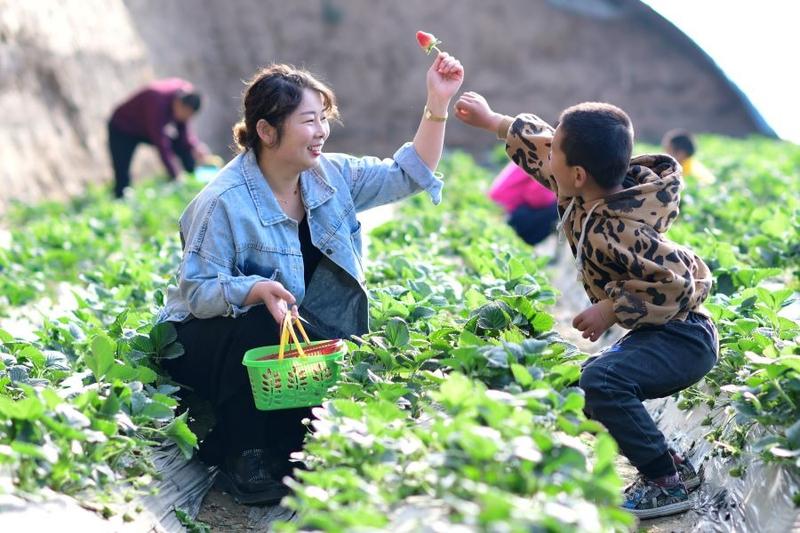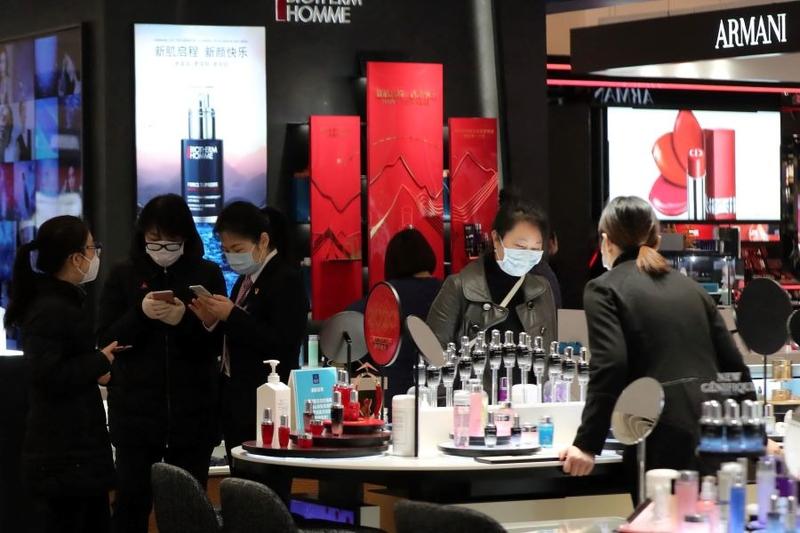 A boy joins his mother to pick strawberries at a plantation cooperative in Hohhot, the Inner Mongolia autonomous region, in April. (WANG ZHENG / FOR CHINA DAILY)
A boy joins his mother to pick strawberries at a plantation cooperative in Hohhot, the Inner Mongolia autonomous region, in April. (WANG ZHENG / FOR CHINA DAILY)
In China, the novel coronavirus didn't just unleash the COVID-19 epidemic-it appears to have also unlocked the purchasing power of hundreds of millions of female consumers, sparking e-sales worth billions of yuan and deepening consumption upgrade.
In the process, the bug may have unwittingly paved the way for actualizing the full potential of e-commerce, and transformed the fortunes of certain categories of products and services like healthcare, household necessities, consumer electronics, kids products like toys and learning aids, and even fashion and cosmetics, in spite of women staying indoors mostly.
Lin Wen, 35, a clerk at a financial institution in Beijing, epitomizes the new-generation Chinese female consumers keen to adapt to a pandemic-stricken world in order to keep life on an even keel. Part of the adaptation process involves mastering the art of online shopping, which is mostly done these days by tapping on smartphone screens.
The country's middle-and high-income female shoppers now demand increasingly diversified and personalized products and services, said industry insiders
ALSO READ: Consumption phoenix may rise from the ashes
Since the outbreak, Lin has been trawling online marketplaces frequently to buy a range of products: hand sanitizers, juice extractor, electric oven, baking ingredients, sportswear, face masks, eye essence, health supplements, what have you.
She has also bought Lego toys and children's books for her little son who will enroll into a primary school in the next academic year. This led to her spending more time playing with him during the outbreak, given the stay-at-home orders of the local authorities.
"Although I have to remain indoors to avoid getting infected, I still manage to buy what's needed via online shopping, which I find to be a lot of fun. I'd like to buy all sorts of protective and healthcare products for my family," Lin said.
Her larger goal is to maintain the quality of life as much as possible during the pandemic. She has downloaded several fitness apps and bought a yoga mat, workout clothes as well as high-end skincare products, in an attempt to stay in good shape, improve her image and temperament.
Thanks to consumers such as Lin, China's e-commerce sector has grown exponentially in recent months. The country's middle-and high-income female shoppers now demand increasingly diversified and personalized products and services, said industry insiders.
It is noteworthy that female consumers are attaching importance to health and spending more on maternal and infant goods, and beauty, makeup, and fitness-related products, they said.
According to a report released by big data service provider QuestMobile, China's online retail sector saw a surge in the number of female users in February when the epidemic peaked in the country. Active female users of mobile shopping rose 8 percent year-on-year to 446 million in February.
During the 29-day month, female users spent an average 157 hours on mobile internet, up nearly 43 percent year-on-year. Each female user spent nearly 7 hours on e-commerce apps on average, up more than 10 percent year-on-year, according to the report.
In February, e-commerce apps Taobao and Pinduoduo figured among the top 10 apps with the most active penetration rates among female users, according to the report. It also cited the increasingly diverse channels for female users in online purchases, including content platforms, social networking platforms and recommendation-based platforms.
Chen Ke, senior partner of consultancy Roland Berger, said during the epidemic, female consumers, who drive household consumption, had sufficient time to satisfy their families' purchasing requirements for daily necessities and healthcare and protective products.
Meanwhile, their demand for cosmetics and clothing was met largely by the booming e-commerce and various promotional activities launched by merchants, Chen said.
A report released by JD Big Data Research Institute said sales of protective products including masks, disposable gloves, and antibacterial wipes increased sharply during the COVID-19 epidemic, and the growth rate of female consumption in this category was much higher than average.
Female consumers tended to spend more money on their children since the outbreak. Sales of toys and musical instruments, amusement equipment and baby milk formula surged 1,440 percent, 1,102 percent and 106 percent year-on-year during the epidemic period from Jan 20 to Feb 10.
Females also tend to entertain themselves as indicated by the 295-percent year-on-year rise in sales of Nintendo's handheld gaming consoles Switch during the same period. Sales of tablet computers also rose 50 percent year-on-year.
Female consumers have been focusing on fitness during the time of self-isolation, which drove sales of yoga mats, body care and female care products up by 142 percent, 117 percent and 66 percent year-on-year during the period of Jan 20 to Feb 10.
The JD Big Data report also concluded female consumers bought more consumer electronics and home appliances in 2019 than previously, while health and fitness have become a new shopping focus. The top five products bought by them last year were cosmetics and skincare products, maternal and infant commodities, personal care products, fresh produce and books.
"E-commerce platforms such as Tmall, JD, Pinduoduo and Vip.com are further tapping female consumption potential through offerings of personalized goods and services," said Mo Daiqing, a senior analyst at the Internet Economy Institute, a domestic consultancy.
"Although the epidemic has affected the brick-and-mortar businesses to some extent, the pent-up consumption demand will be further unleashed when the epidemic dies down."
According to Mo, female consumers born in the 1980-90 period are fond of sharing their photos and pleasures in daily lives on WeChat, Weibo and other social media platforms, and buying products based on recommendations of their friends and some online communities.
Social e-commerce shopping apps such as Red, known as Xiaohongshu, and Meiyou have gained traction among the urban females born in the 1990s. The latter value quality, and have relatively high consuming power and premium tastes.
Although affected by the epidemic, sales of cosmetics on Red still maintained steady growth, with online searches for beauty, and makeup-and-skincare content rising 74 percent and 126 percent in February compared with January.
READ MORE: Consumption upgrade powering demand for luxury goods
Data from QuestMobile showed the daily active users of Red grew 35 percent during the Spring Festival holiday (Jan 24 to Feb 2) from a year earlier, and its average daily usage time grew 44.9 percent year-on-year (but it did not provide absolute figures to substantiate its data).
The purchasing potential of females has been further unleashed during the International Women's Day shopping gala held on March 8 by tech behemoth Alibaba Group Holding Ltd.
More than 20,000 brands doubled their sales on its business-to-consumer arm Tmall during the promotional event from a year earlier, while the sales revenue from livestreaming Taobao vendors surged 264 percent compared with the previous year. Taobao attracted 1 million new shopkeepers in February.
Wenzhou, Zhejiang province-based shoemaker Red Dragonfly, which held more than 400 livestreaming events, saw its daily revenue surge over 1 million yuan ($142,000) within just nine days.
 Consumers pick cosmetics at a mall in Wuhan, Hubei province, on March 30. (WANG JING / CHINA DAILY)
Consumers pick cosmetics at a mall in Wuhan, Hubei province, on March 30. (WANG JING / CHINA DAILY)
"Based on our data and observation in the latest survey, female consumers paid more attention to health, safety and protection of individuals and families during the epidemic, and also endured more pressure from both inside and outside," said Laurel Gu, category director of Mintel China, a consultancy firm.
Gu noted that in terms of consumer behavior, women, especially those aged between 40 and 59, are more concerned about the exposure to the virus in daily lives than men, so they keep an eye on the supply of health protection-related products, such as masks and disinfectants in market. They also prefer cooking at home rather than ordering takeouts.
"The pandemic has also boosted online shopping. Some 80 percent of female respondents said they were more willing to purchase homegrown brands after the outbreak, a shift in consumption attitudes that might have an impact on their buying choices at online and offline channels for a long period of time," Gu said.
A Nielsen survey showed that women were more concerned with smart and technology products than men. Compared with men, women had stronger willingness to buy intelligent products, ranging from such home accessories as smart speakers and home theater to big-ticket items like smart vehicles.
The COVID-19 epidemic is quickly revolutionizing how Chinese consumers think about their health, as well as changing their purchasing behavior and the channels they are using to shop, said Justin Sargent, president of Nielsen China.
"It is both a challenge and an opportunity for brands and retailers. With the advent of 5G, augmented reality, artificial intelligence, and a shifting market environment, brand owners should be continually embracing change while exploring new business strategies."


